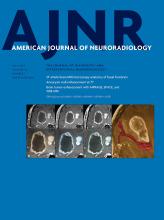Index by author
King, K.
- SpineYou have accessSubject-Specific Studies of CSF Bulk Flow Patterns in the Spinal Canal: Implications for the Dispersion of Solute Particles in Intrathecal Drug DeliveryW. Coenen, C. Gutiérrez-Montes, S. Sincomb, E. Criado-Hidalgo, K. Wei, K. King, V. Haughton, C. Martínez-Bazán, A.L. Sánchez and J. C. LasherasAmerican Journal of Neuroradiology July 2019, 40 (7) 1242-1249; DOI: https://doi.org/10.3174/ajnr.A6097
Kishima, H.
- FELLOWS' JOURNAL CLUBNeurointerventionYou have accessLong-Term Results and Follow-Up Examinations after Endovascular Embolization for Unruptured Cerebral AneurysmsT. Murakami, T. Nishida, K. Asai, Y. Kadono, H. Nakamura, T. Fujinaka and H. KishimaAmerican Journal of Neuroradiology July 2019, 40 (7) 1191-1196; DOI: https://doi.org/10.3174/ajnr.A6101
The appropriate period of follow-up examinations after endovascular embolization for cerebral aneurysms using time-of-flight MR angiography is not well-known. Between April 2006 and March 2011, one hundred forty-eight unruptured aneurysms were treated with endovascular coil embolization. Among them, the authors investigated 116 unruptured aneurysms, which were followed up for >5 years. Time-of-flight MRA was performed at 1 day, 3–6 months, 1 year after the procedure, and every year thereafter. The mean follow-up period was 7.0 years. Recanalization was observed in 19 (16.3%) aneurysms within 2 years. Among them, retreatment was performed in 8 (6.8%) aneurysms. No recanalization was detected in any aneurysms that had been stable in the first 2 years after embolization. They conclude that aneurysms in which recanalization was not observed within 2 years after endovascular coil embolization were stable during a mean follow-up of 7 years. This result may be helpful in considering the appropriate span or frequency of follow-up imaging for embolized cerebral aneurysms.
Kleinloog, R.
- Adult BrainYou have accessGadolinium Enhancement of the Aneurysm Wall in Unruptured Intracranial Aneurysms Is Associated with an Increased Risk of Aneurysm Instability: A Follow-Up StudyM.D.I. Vergouwen, D. Backes, I.C. van der Schaaf, J. Hendrikse, R. Kleinloog, A. Algra and G.J.E. RinkelAmerican Journal of Neuroradiology July 2019, 40 (7) 1112-1116; DOI: https://doi.org/10.3174/ajnr.A6105
Korutz, A.W.
- FunctionalOpen AccessA Practical Review of Functional MRI Anatomy of the Language and Motor SystemsV.B. Hill, C.Z. Cankurtaran, B.P. Liu, T.A. Hijaz, M. Naidich, A.J. Nemeth, J. Gastala, C. Krumpelman, E.N. McComb and A.W. KorutzAmerican Journal of Neuroradiology July 2019, 40 (7) 1084-1090; DOI: https://doi.org/10.3174/ajnr.A6089
Koskas, P.
- Adult BrainYou have accessImproving Detection of Multiple Sclerosis Lesions in the Posterior Fossa Using an Optimized 3D-FLAIR Sequence at 3TA. Lecler, I. El Sanharawi, J. El Methni, O. Gout, P. Koskas and J. SavatovskyAmerican Journal of Neuroradiology July 2019, 40 (7) 1170-1176; DOI: https://doi.org/10.3174/ajnr.A6107
Krebs, J.M.
- NeurointerventionYou have accessFlow-Pattern Details in an Aneurysm Model Using High-Speed 1000-Frames-per-Second AngiographyJ.M. Krebs, A. Shankar, S.V. Setlur Nagesh, J.M. Davies, K.V. Snyder, E.I. Levy, L.N. Hopkins, M. Mokin, D.R. Bednarek, A.H. Siddiqui and S. RudinAmerican Journal of Neuroradiology July 2019, 40 (7) 1197-1200; DOI: https://doi.org/10.3174/ajnr.A6090
Krings, T.
- EDITOR'S CHOICEPediatricsYou have accessPredictive Value of MRI in Diagnosing Brain AVM Recurrence after Angiographically Documented Exclusion in ChildrenA. Jhaveri, A. Amirabadi, P. Dirks, A.V. Kulkarni, M.M. Shroff, N. Shkumat, T. Krings, V.M. Pereira, V. Rea and P. MuthusamiAmerican Journal of Neuroradiology July 2019, 40 (7) 1227-1235; DOI: https://doi.org/10.3174/ajnr.A6093
The authors sought to determine the predictive values of contrast-enhanced MR imaging and TOF-MRA for brain AVM recurrence in children, compared with conventional angiography, in 39 patients (mean 10.8 years of age, mean Spetzler-Martin grade, 1.9). Features predictive of recurrence included a tuft of vessels on TOF-MRA and nodular juxtamural/linear enhancement with a draining vein on contrast-enhanced MR imaging. MR imaging is useful for surveillance after brain AVM treatment in children, but conventional angiography is required for definitive diagnosis of recurrence. TOF-MRA and contrast-enhanced MR imaging provide complementary information for determining brain AVM recurrence and should be interpreted in conjunction.
Krumpelman, C.
- FunctionalOpen AccessA Practical Review of Functional MRI Anatomy of the Language and Motor SystemsV.B. Hill, C.Z. Cankurtaran, B.P. Liu, T.A. Hijaz, M. Naidich, A.J. Nemeth, J. Gastala, C. Krumpelman, E.N. McComb and A.W. KorutzAmerican Journal of Neuroradiology July 2019, 40 (7) 1084-1090; DOI: https://doi.org/10.3174/ajnr.A6089
Kulkarni, A.V.
- EDITOR'S CHOICEPediatricsYou have accessPredictive Value of MRI in Diagnosing Brain AVM Recurrence after Angiographically Documented Exclusion in ChildrenA. Jhaveri, A. Amirabadi, P. Dirks, A.V. Kulkarni, M.M. Shroff, N. Shkumat, T. Krings, V.M. Pereira, V. Rea and P. MuthusamiAmerican Journal of Neuroradiology July 2019, 40 (7) 1227-1235; DOI: https://doi.org/10.3174/ajnr.A6093
The authors sought to determine the predictive values of contrast-enhanced MR imaging and TOF-MRA for brain AVM recurrence in children, compared with conventional angiography, in 39 patients (mean 10.8 years of age, mean Spetzler-Martin grade, 1.9). Features predictive of recurrence included a tuft of vessels on TOF-MRA and nodular juxtamural/linear enhancement with a draining vein on contrast-enhanced MR imaging. MR imaging is useful for surveillance after brain AVM treatment in children, but conventional angiography is required for definitive diagnosis of recurrence. TOF-MRA and contrast-enhanced MR imaging provide complementary information for determining brain AVM recurrence and should be interpreted in conjunction.
Kundu, S.
- Adult BrainOpen AccessAssessing Postconcussive Reaction Time Using Transport-Based Morphometry of Diffusion Tensor ImagesS. Kundu, A. Ghodadra, S. Fakhran, L.M. Alhilali and G.K. RohdeAmerican Journal of Neuroradiology July 2019, 40 (7) 1117-1123; DOI: https://doi.org/10.3174/ajnr.A6087








